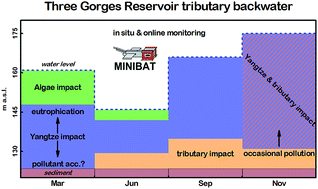Environmental water body characteristics in a major tributary backwater of the unique and strongly seasonal Three Gorges Reservoir, China†
Abstract
Ecological consequences of large dams, particularly regarding the Three Gorges Dam (TGD) on the Yangtze River in China, have been controversially and internationally discussed. Water quality within the Three Gorges Reservoir (TGR) has been deteriorated by highly underestimated eutrophication and algal blooms. Globally, the TGR is delineated from other comparable reservoirs by its low mean water residence time and its 30 m annual water level fluctuation. We used an in situ and online multi-sensor system ‘MINIBAT’ to analyse eight indicative physico-chemical parameters across depth and time within the Xiangxi River backwater, a representative major tributary of the TGR. The results revealed considerably changing environmental water body characteristics within the tributary backwater related to the TGR's typical seasonal hydrology. The Yangtze River main stream appeared to be the major contributor of dissolved and particulate water constituents within the Xiangxi River backwater. Eutrophication problems in spring and summer seasons are likely a consequence of extensive water mass exchange and pollutant transport processes in autumn and winter. In particular, the backwater’s permanently stratified water column shows varying layered impacts of the Yangtze River main stream and Xiangxi River headwaters. This is a clear indication of a complex stratified flow pattern within this TGR tributary backwater. In our study, a major driver for the Yangtze River main stream impact was the rising TGR water level. The TGR's globally unique characteristics have thus become a central part of the recent eutrophication and pollution problem within the TGR. Thereof, we deduced a proposal for an adapted dam management strategy.


 Please wait while we load your content...
Please wait while we load your content...